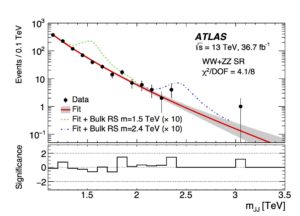The UMass ATLAS group led by faculty members Willocq, Dallapiccola, and Brau played a key role in this week’s preliminary observation of a new particle, possibly the long-sought Higgs boson, announced by scientists at the European Organization for Nuclear Research (CERN) particle physics laboratory. It is located at the Large Hadron Collider (LHC) deep below Switzerland and France.

The Standard Model of particle physics can correctly explain the elementary particles and forces of nature after more than four decades of experiments. But it cannot, without the Higgs boson, explain how most of these particles acquire their mass, which is a key ingredient in the formation of the universe. Though scientists are not certain this week that the new particle is indeed a Higgs, Willocq and colleagues at UMass Amherst are elated by the possibility and excited that their work since joining the international team eight years ago is paying off.
The UMass Amherst physicists work on the ATLAS project, one of two general-purpose detectors at the LHC used to detect the debris from the collisions of the LHC’s high-energy beams of protons. The UMass group has significant contributions to the identification and reconstruction of muons, a kind of particle produced in some of these collisions and a key component of the Higgs search. They have written large parts of the code now used to reconstruct the trajectories of muons detected in the ATLAS Muon Spectrometer.
Willocq says, “The ability to find muons among the debris of the proton collisions from the collider is critical to the research done with ATLAS. The long-sought Higgs boson is being hunted by hundreds of particle physicists eager to discover this hypothetical particle or disprove its existence. Higgs bosons may manifest themselves by decaying into muons as well as other particles. By identifying and measuring those muons and accompanying Higgs decay particles we hope to find evidence for the Higgs. Muons thus provide telltale signs of the ephemeral presence of a Higgs boson produced by the collider.”
A muon is a negatively charged, unstable elementary particle similar to the electron, but about 200 times heavier. The ATLAS detector includes a huge magnet that bends the paths of charged particles to allow their momenta to be measured. The device records and measures particles created in collisions, along with their paths, energies and identities.
Willocq adds, “We are responsible for the maintenance and further development of the muon event data classes, as well as substantial parts of the reconstruction software. Since joining ATLAS in 2004, we have held coordinator positions for muon reconstruction, muon software, muon combined data quality and muon combined performance. Graduate students have also played a significant role in the commissioning and continued operation of the endcap Muon Spectrometer detector system, as well as the muon data acquisition.”
Scientists at the LHC announced their latest results at a seminar at the LHC in Switzerland this week on July 4. Physicists from across the United States had gathered at laboratories and universities in the middle of the night to watch a live video stream of the seminar online. Most U.S. scientists participate in experiments from their home institutions, remotely accessing and analyzing their data through high-capacity networks and grid computing.
It was in 1964 that Peter Higgs proposed the existence of a new particle, now known as the Higgs boson, whose coupling with other particles would determine their mass, but it has eluded discovery. Now scientists are approaching the moment of knowing whether the Higgs is the right solution to this problem.
More than 1,700 people from U.S. institutions, including 89 American universities and seven U.S. Department of Energy national laboratories, helped design, build and operate the LHC accelerator and its four particle detectors. The U.S. Department of Energy’s Office of Science and the National Science Foundation provide support for research and detector operations at the LHC along with computing for the ATLAS experiment.
Preliminary findings announced this week are based on data collected in 2011 and 2012, while 2012 data are still under analysis. More presentations about the results from the CERN particle physics lab can be found at the International Conference on High Energy Physics Melbourne, Australia.
 A new LHC Run 2 search for diboson (WW, WZ and ZZ) resonances has been carried out with 37 inverse femtobarns of pp collisions collected by the ATLAS detector in 2015 and 2016. The search exploits jet substructure techniques to tag hadronic jets originating from the decay of W or Z bosons. The paper has been submitted to Phys. Lett. B, see http://arxiv.org/abs/1708.04445. Prof. Willocq, postdoctoral Research Associate Picazio and graduate student Meadows had responsibility for multiple aspects of the analysis (e.g. evaluating the boson-tagging performance, studying the modeling of the background, determining large-radius jet systematic uncertainties, etc.) and editing of the paper.
A new LHC Run 2 search for diboson (WW, WZ and ZZ) resonances has been carried out with 37 inverse femtobarns of pp collisions collected by the ATLAS detector in 2015 and 2016. The search exploits jet substructure techniques to tag hadronic jets originating from the decay of W or Z bosons. The paper has been submitted to Phys. Lett. B, see http://arxiv.org/abs/1708.04445. Prof. Willocq, postdoctoral Research Associate Picazio and graduate student Meadows had responsibility for multiple aspects of the analysis (e.g. evaluating the boson-tagging performance, studying the modeling of the background, determining large-radius jet systematic uncertainties, etc.) and editing of the paper.






